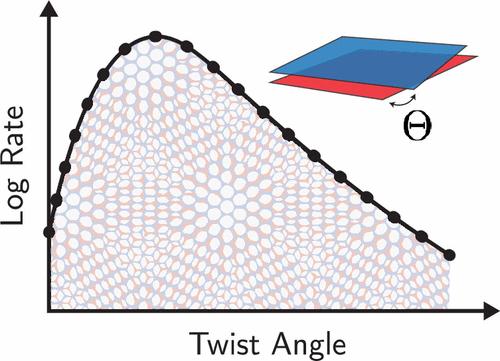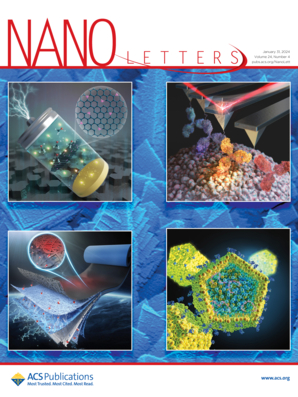Microscopic Origin of Twist-Dependent Electron Transfer Rate in Bilayer Graphene
IF 9.6
1区 材料科学
Q1 CHEMISTRY, MULTIDISCIPLINARY
引用次数: 0
Abstract
Using molecular simulation and continuum dielectric theory, we consider how electrochemical kinetics are modulated by the twist angle in bilayer graphene electrodes. By establishing a connection between the twist angle and the screening length of charge carriers within the electrode, we investigate how tunable metallicity modifies the statistics of the electron transfer energy gap. Constant potential molecular simulations show that the activation free energy for electron transfer increases with screening length, leading to a non-monotonic dependence on the twist angle. The twist angle alters the density of states, tuning the number of thermally accessible channels for electron transfer and the reorganization energy by affecting the stability of the vertically excited state through attenuated image charge interactions. Understanding these effects allows us to express the Marcus rate of interfacial electron transfer as a function of the twist angle in a manner consistent with experimental observations.

双层石墨烯中扭曲电子转移率的微观起源
利用分子模拟和连续介质理论,我们研究了双层石墨烯电极的扭转角如何调节电化学动力学。通过在扭转角和电极内电荷载流子的屏蔽长度之间建立联系,我们研究了可调金属性如何改变电子转移能隙的统计量。恒电位分子模拟显示,电子转移的活化自由能随着屏蔽长度的增加而增加,从而导致对扭曲角的非单调依赖。扭转角改变了状态密度,通过衰减的图像电荷相互作用影响了垂直激发态的稳定性,从而调整了电子转移的热可达通道数量和重组能。了解了这些影响之后,我们就能将马库斯的界面电子转移率表示为与实验观察结果一致的扭转角函数。
本文章由计算机程序翻译,如有差异,请以英文原文为准。
求助全文
约1分钟内获得全文
求助全文
来源期刊

Nano Letters
工程技术-材料科学:综合
CiteScore
16.80
自引率
2.80%
发文量
1182
审稿时长
1.4 months
期刊介绍:
Nano Letters serves as a dynamic platform for promptly disseminating original results in fundamental, applied, and emerging research across all facets of nanoscience and nanotechnology. A pivotal criterion for inclusion within Nano Letters is the convergence of at least two different areas or disciplines, ensuring a rich interdisciplinary scope. The journal is dedicated to fostering exploration in diverse areas, including:
- Experimental and theoretical findings on physical, chemical, and biological phenomena at the nanoscale
- Synthesis, characterization, and processing of organic, inorganic, polymer, and hybrid nanomaterials through physical, chemical, and biological methodologies
- Modeling and simulation of synthetic, assembly, and interaction processes
- Realization of integrated nanostructures and nano-engineered devices exhibiting advanced performance
- Applications of nanoscale materials in living and environmental systems
Nano Letters is committed to advancing and showcasing groundbreaking research that intersects various domains, fostering innovation and collaboration in the ever-evolving field of nanoscience and nanotechnology.
 求助内容:
求助内容: 应助结果提醒方式:
应助结果提醒方式:


